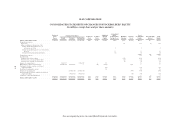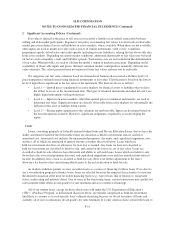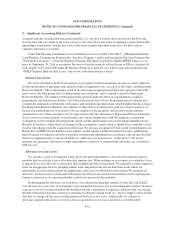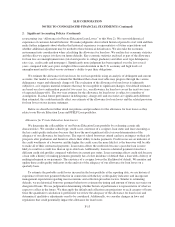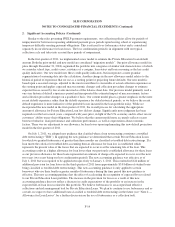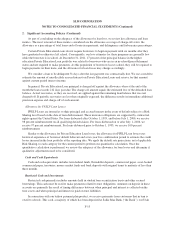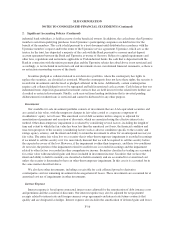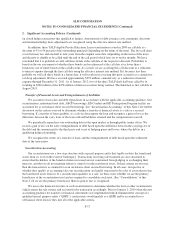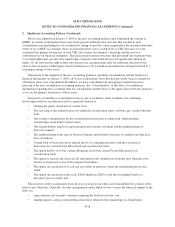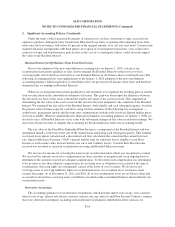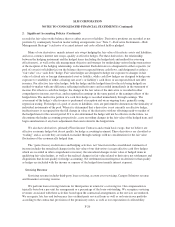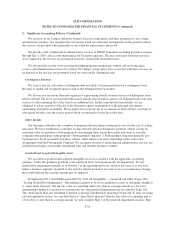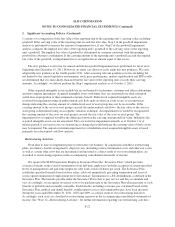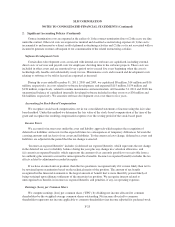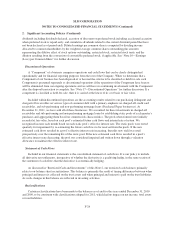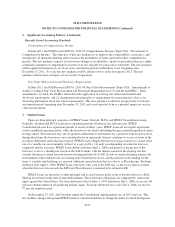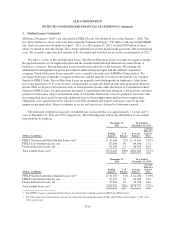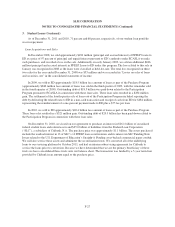Sallie Mae 2011 Annual Report Download - page 126
Download and view the complete annual report
Please find page 126 of the 2011 Sallie Mae annual report below. You can navigate through the pages in the report by either clicking on the pages listed below, or by using the keyword search tool below to find specific information within the annual report.SLM CORPORATION
NOTES TO CONSOLIDATED FINANCIAL STATEMENTS (Continued)
2. Significant Accounting Policies (Continued)
on closed hedge transactions that qualified as hedges. Amortization of debt issuance costs, premiums, discounts
and terminated hedge basis adjustments are recognized using the effective interest rate method.
In addition, three TALF eligible Private Education Loan securitizations issued in 2009 are callable at a
discount of 93 or 94 percent of the outstanding principal (depending on the terms of the note). The first call dates
occur between two and one-half to four years from the original issue date (depending on the terms of the note)
and the note is eligible to be called until the end of the call period which lasts six to twelve months. We have
concluded that it is probable we will call these bonds at the call date at the respective discount. Probability is
based on the our assessment of whether these bonds can be refinanced at the call date at or lower than a
breakeven cost of funds based on the call discount. As a result, we are accreting this call discount as a reduction
to interest expense through the first call date using the effective interest rate method. If it becomes less than
probable we will call these bonds at a future date, it will result in us reversing this prior accretion as a cumulative
catch-up adjustment. We have accreted approximately $278 million, cumulatively, as a reduction of interest
expense through December 31, 2011. As of January 2012, two of the three TALF deals had been called by us
resulting in $238 million of the $278 million of interest accretion being realized. The third deal is first callable in
August 2013.
Transfer of Financial Assets and Extinguishments of Liabilities
We account for loan sales and debt repurchases in accordance with the applicable accounting guidance. Our
securitizations, indentured trust debt, ABCP borrowings, ED Conduit and ED Participation Program facility are
accounted for as on-balance sheet secured borrowings. See “Securitization Accounting” of this Note 2 for further
discussion on the criteria assessed to determine whether a transfer of financial assets is a sale or a secured
borrowing. If a transfer of loans qualifies as a sale we derecognize the loan and recognize a gain or loss as the
difference between the carry basis of the loan sold and liabilities retained and the compensation received.
We periodically repurchase our outstanding debt in the open market or through public tender offers. We
record a gain or loss on the early extinguishment of debt based upon the difference between the carrying cost of
the debt and the amount paid to the third party and is net of hedging gains and losses, where the debt is in a
qualifying hedge relationship.
We recognize the results of a transfer of loans and the extinguishment of debt based upon the settlement
date of the transaction.
Securitization Accounting
Our securitizations use a two-step structure with a special purpose entity that legally isolates the transferred
assets from us, even in the event of bankruptcy. Transactions receiving sale treatment are also structured to
ensure that the holders of the beneficial interests issued are not constrained from pledging or exchanging their
interests, and that we do not maintain effective control over the transferred assets. If these criteria are not met,
then the transaction is accounted for as an on-balance sheet secured borrowing. In all cases, irrespective of
whether they qualify as accounting sales our securitizations are legally structured to be sales of assets that isolate
the transferred assets from us. If a securitization qualifies as a sale, we then assess whether we are the primary
beneficiary of the securitization trust and are required to consolidate such trust. (See “Consolidation” of this
Note 2.) If we are the primary beneficiary then no gain or loss is recognized.
We assess the financial structure of each securitization to determine whether the trust or other securitization
vehicle meets the sale criteria and account for the transaction accordingly. Prior to January 1, 2010 when the new
accounting guidance for transfers of financial instruments was implemented which eliminated the concept of a
qualified special purpose entity (“QSPE”), certain trusts would qualify as a QSPE and be accounted for as
off-balance sheet trusts if they met all of the applicable criteria.
F-17


